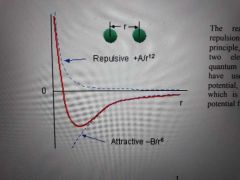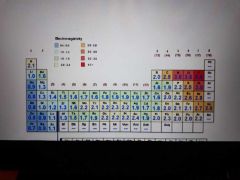![]()
![]()
![]()
Use LEFT and RIGHT arrow keys to navigate between flashcards;
Use UP and DOWN arrow keys to flip the card;
H to show hint;
A reads text to speech;
22 Cards in this Set
- Front
- Back
|
Cohesive energy definition |
Energy needed to break a solid apart into neutral atoms. |
|
|
Cohesive energy equation |
Cohesive energy(A+B-> A+ +B-) = ionization energy (A)- electron affinity(B) |
|
|
The five types of bonding |
Ionic covalent metallic van der waals hydrogen |
|
|
Expression for inter-atomic potential |
A/r^n - b/r^m Where the n term is the negative force and is due to the Paul I exclusion principle n is often a value such as 12 where m is due to the bonding and max is around 6 |
|
|
Potential graph |

Red line is the combination of the attractive and repulsive forces when diffreniated and equal to 0 this is the equilibrium distance where forces are balenced. |
|
|
Pauli Exclusion Principle |
No two identical fermions may simultaneously occupy the same quantum state. When brought together they experience pauli repulsion. |
|
|
Ionic bonding description |
Electron is physically transferred from one atom to another and resulting ions attract each other |
|
|
Ionic bonding compounds |
Very different electronegativies NaCl CsCl CsI |
|
|
Ionic bonding properties |
Hard brittle high melting temp insulators water soluble |
|
|
Covalent bonding description |
Electron shared between two atoms forming a bond energy is lowered by delocaluzation of wavefunction |
|
|
Covalent compounds |
Similar electronegativies GaAs Si Ge polymers |
|
|
Covalent properties |
Very hard brittle high melting temp insulators/semiconductors |
|
|
Metallic description |
Electrons delocalised and free to move throughout the solid forming a glue between positive ions. |
|
|
Metallic compounds |
Metals on left and middle of periodic table. |
|
|
Metallic properties |
Ductile malleable low melting point magnetism |
|
|
Molecular van der waals description |
Dipole moments on constituents align to cause attraction strength increases with the size of the molecule or polarity |
|
|
Van der waals compounds |
Noble has solids |
|
|
Van der waals properties |
Soft weak low melting points electrical insulators |
|
|
Hydrogen bonding description |
H-ion bound to one atom but still attracted to another special case |
|
|
H-bonding compounds |
Organic chemicals and biological systems water |
|
|
H-bonding properties |
Weak bonding stronger than vdw maintains shape of DNA |
|
|
Electronegativity |

Ruffly increase to the right |

